How to cook millet with step by step pictures for easy understanding. Millets are a group of highly variable small-seeded grasses, widely grown around the world as cereal crops or grains. Lets learn how to cook millet in this post.
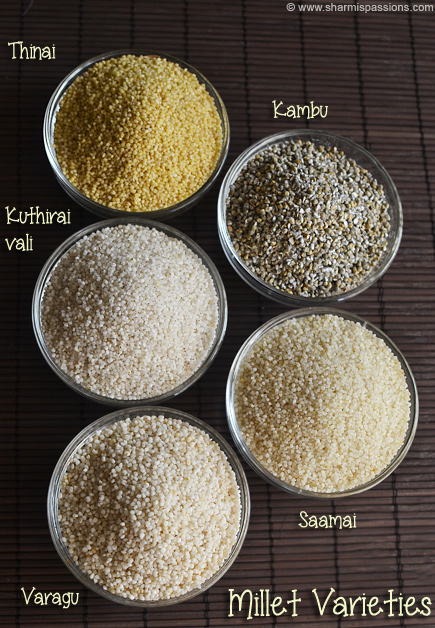
How to cook millet with different varieties of millet is included in this post. I have shared 3methods for cooking millet which includes open pan method, pressure cooker method and instant pot method. I would prefer the pan method for making plain rice variety and pressure cooker method for making upma / pongal.
Here is a compiled millet post of how to cook, millet recipes etc. As for the past few months I had been buying one variety of millet each month and had been experimenting and this time I got all of them(as shown above) as now I am confident enough. I learnt cooking millet from the cookbook my neighbour gave me, even the measures I got it from there.And its time we take pride in cooking these ancient mostly forgotten miracle grains.
Millet Recipes
The millet varieties can easily be substituted for rice and wheat. The recipes I have tried so far are:
1.Thinai Upma, Thinai Payasam
2.Kambu Koozh, Kambu Thayir Sadam, Kambu Sadam, Kambu Dosai
3.Varagu Pongal
4.Kuthirai Vali Idiyappam
5.Ragi Malt, Ragi Kozhukattai
6.Millet porridge
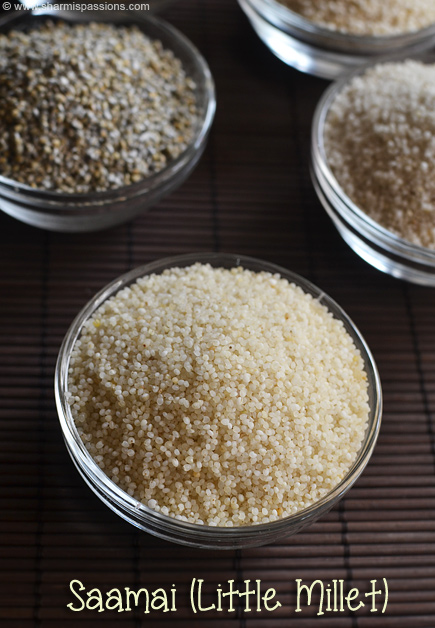
Kinds of Millets
English – Tamil – Hindi
- Pearl millet – Kambu – Bajra
- Foxtail millet – Thainai – Kangni
- Kodo Millet – Varagu – Kodra
- Barnyard Millet – Kuthiraivali – Jhangora
- Little Millet – Saamai – Kutki
- Finger Millet – Kelveragu – Mandua
- Sorgum – Cholam – Jowar
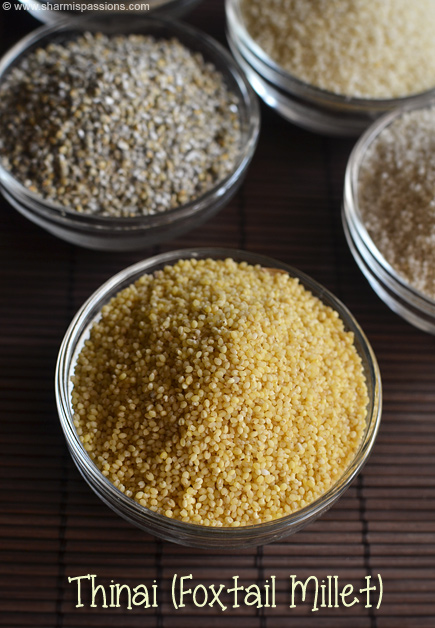
Preparing millets
Millets sold in grocery stores are already clean so you can jus rinse and start to use it right away. However some millets needs soaking to cook faster. Soaking helps to get soft grains also cooks quickly. Soaking time may differ for each millet variety.
For pongal and upma I usually toast the millet along with tempering to get more enahanced flavour. Otherwise you can use it as such too as there is not much taste difference. A very mild toasty flavour comes which you can feel in the taste only if you are so keen about it like me.
Millet Water Ratio
The water ratio slightly differs according to the consistency you prefer and the type of recipe.Find below the given measures for grain seperated millets for using it for variety rice or pulao varieties etc. If you are using it for porridge or khichdi or pongal recipes then water ratio might differ(refer to individual recipes here). This works for most millets including kodo millet, little millet, barnyard millet, foxtail millet etc.
1. Open pot method – Millet pulao
- For soaked millet : For 1 cup millet use 1.5 cups water
- For unsoaked millet : For 1 cup millet use 2.5 cups water
2.Pressure cooker method – Millet pongal
- For soaked millet : For 1 cup millet use 1.5 cups water
- For unsoaked millet : For 1 cup millet use 2 cups water
3.Instant Pot Method
- For soaked millet : For 1 cup millet use 1.5 cups water
- For unsoaked millet : For 1 cup millet use 2 cups water
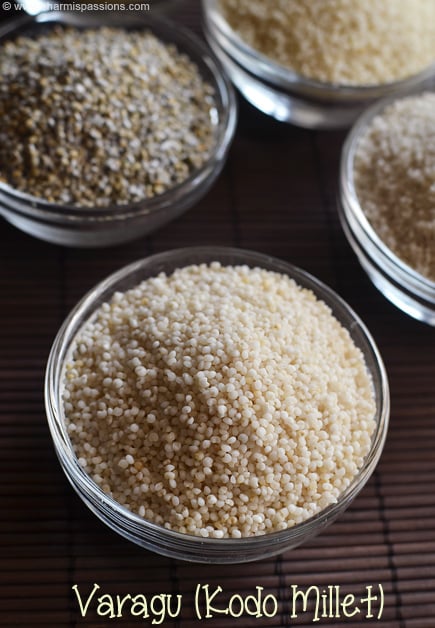
📖 Recipe Card
How to cook millet
Ingredients
Open pot method
- 1 cup millet
- 4 cups water
Pressure cooker method
- 1 cup millet
- 3 cups* water
* Water quantity slightly differs for thinai and kambu alone. Check my notes section.
Instructions
- Clean the millet first and remove any grits if any.
- Take the millet (I used varagu here), rinse it in water and set aside.
- Boil water. Here I have used only 1/4 cup of millet so adjusted water quantity accordingly.
- Add the rinsed millet, and let it cook covered till all the moisture is absorbed and the grain is cooked till soft.
- Once all the water has been absorbed by the millet, switch off and keep aside for 10mins by that resting time it will cook further. Then fluff it up with a ladle.
- Serve millet hot with sambar and any veggie of your choice.
Notes
- For thinai alone soak for an hour and cook else it will take longer or you will need to add more water.Check thinai upma recipe.
- If you want pulav style grains then use 2 to 2 and 1/2 cups of water if you want it little more mushy then 3 cups water will be perfect.If you want to make variety rice then use 2 and 1/2 cups of water.
- And if you want more creamier porridge consistency then add 4 cups of water.
- Rinsing is optional.While washing take care as the grains are tiny it gets easily washed away with water, You can use a big wide strainer to wash/rinse the millets.
- Also you can even roast the millet for few mins to enhance the nutty flavour of the grain.
- Serve millets always hot / warm exceptional for kambu alone.
- The time required to cook depends on each millet variety.
- You can make any variety rice or khichdi with the millets just substitute millet for rice.
- In the varagu sadam pic above you see I used 2 and 1/2 cups of water to get it grain separated as I wanted to make lemon rice with it.
- As I made just 1/4 cup I used my small pan but if you are making 1 cup or more use a thick bottomed vessel to cook to avoid sticking at the bottom.
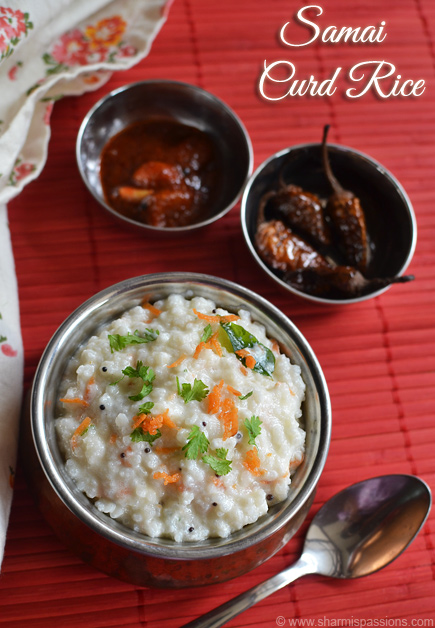
If you have any more questions about this How to cook millet do mail me at [email protected]. In addition, follow me on Instagram, Facebook, Pinterest, Youtube and Twitter .
Tried this How to cook millet ? Do let me know how you liked it. Also tag us on Instagram @sharmispassions and hash tag it on #sharmispassions.
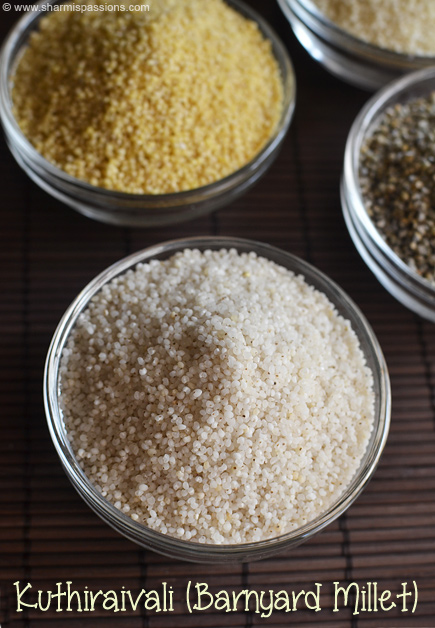
How to cook millet (step by step method)
Open pot method
- Clean the millet first and remove any grits if any.Take the millet(I used varagu here), rinse it in water and set aside.Boil water. Here I have used only 1/4 cup of millet so adjusted water quantity accordingly.

- Add the rinsed millet, and let it cook covered till all the moisture is absorbed and the grain is cooked till soft.

- Once all the water has been absorbed by the millet, switch off and keep aside for 10mins by that resting time it will cook further.Then fluff it up with a laddle.

Serve hot with sambar and any veggie of your choice.
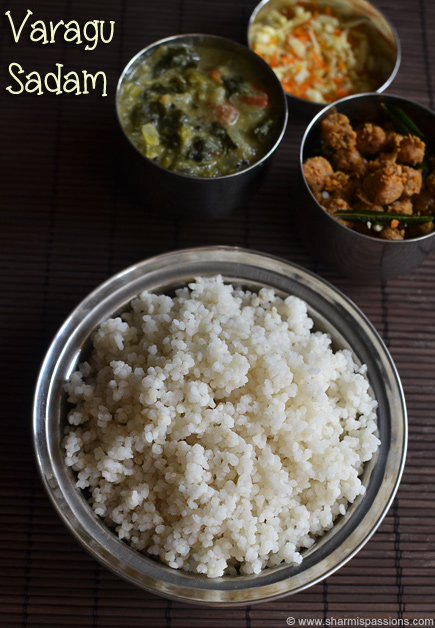
Expert Tips
- For thinai alone soak for an hour and cook else it will take longer or you will need to add more water.Check thinai upma recipe.
- If you want pulav style grains then use 2 to 2 and 1/2 cups of water if you want it little more mushy then 3 cups water will be perfect.If you want to make variety rice then use 2 and 1/2 cups of water.
- And if you want more creamier porridge consistency then add 4 cups of water.
- Rinsing is optional.While washing take care as the grains are tiny it gets easily washed away with water, You can use a big wide strainer to wash/rinse the millets.
- Also you can even roast the millet for few mins to enhance the nutty flavour of the grain.
- Serve millets always hot / warm exceptional for kambu alone.
- The time required to cook depends on each millet variety.
- You can make any variety rice or khichdi with the millets just substitute millet for rice.
- In the varagu sadam pic above you see I used 2 and 1/2 cups of water to get it grain separated as I wanted to make lemon rice with it.
- As I made just 1/4 cup I used my small pan but if you are making 1 cup or more use a thick bottomed vessel to cook to avoid sticking at the bottom.
FAQ’s
1.What is Millet?
Millets are a group of highly variable small-seeded grasses, widely grown around the world as cereal crops or grains. Millets are known as “Small Grains” or “Siru Thaaniyangal” in Tamil.Millets are one of the oldest foods known to humans and possibly the first cereal grain to be used for domestic purposes.Millets are also unique due to their short growing season. They can develop from planted seeds to mature, ready to harvest plants in as little as 65 days. This is important in heavily populated areas. When properly stored, whole millets will keep for two or more years.
2.Why to eat millets?
- Millets are gluten free, rich in fiber and proteins.
- Their rapid growth and shorter growing seasons make millets ideal for emergency, late-planted, and double cropping situations.So mostly they are grown organic without any pesticides and chemicals.
- Millets are highly nutritious, non-glutinous and not acid forming foods. Hence they are soothing and easy to digest.
- Compared to rice, especially polished rice, millets release lesser percentage of glucose and over a longer period of time. This lowers the risk of diabetes.
- Millets are particularly high in minerals like iron, magnesium, phosphorous and potassium. Finger millet (Ragi) is the richest in calcium content, about 10 times that of rice or wheat.
3.Where to buy Millets?
Try getting millets in organic stores or at any trusted supermarket so that its already cleaned else you will have to take the pain of cleaning to remove husk if any.
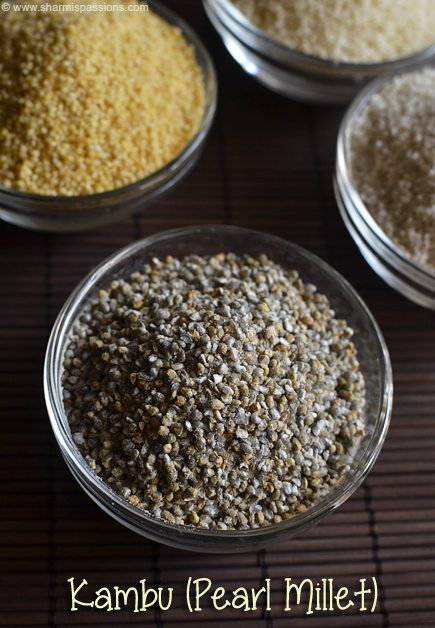



Florence Jasmine David
Very well narrated
Kiruthika
Awesome information very usefull tips to cook millets
Naachammai
Hello, this has been very useful to me. time and again i check these for cooking millets. thanks a lot 🙂
Nanda
Very helpful information and guidance on how to cook millets